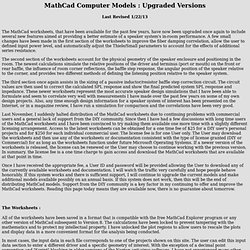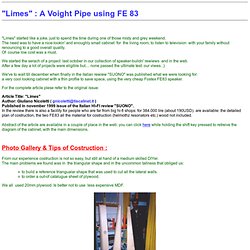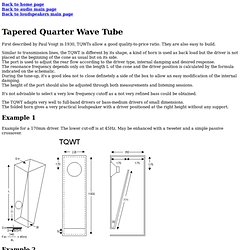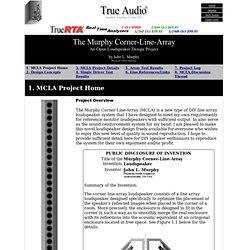

MathCad Computer Models : Upgraded Versions. Last Revised 1/22/13 The MathCad worksheets, that have been available for the past few years, have now been upgraded once again to include several new features aimed at providing a better estimate of a speaker system's in-room performance.

A few small changes have been made in the first section of the worksheets to improve the fiber damping correlation, allow the user to defined input power level, and automatically adjust the Thiele/Small parameters to account for the effects of additional series resistance. *** Limes : a Voight Pipe with Fostex FE83 *** "Limes" : A Voight Pipe using FE 83 "Limes" started like a joke, just to spend the time during one of those misty and grey weekend.The need was to have a nice-lookin' and enoughly small cabinet for the living room, to listen to television with your family without renouncing to a good overall quality.Of course low cost was a must.

We started the serach of a project last october in our collection of speaker-buildn' rewiews and in the web.After a few day a lot of projects were eligible but.... none passed the ultimate test: our viwes. ;) We've to wait till december when finally in the italian rewiew "SUONO" was published what we were looking for:a very cool looking cabinet with a thin profile to save space, using the very cheap Fostex FE83 speaker. Tapered Quarter Wave Tube. Back to home pageBack to audio main pageBack to loudspeakers main page First described by Paul Voigt in 1930, TQWTs allow a good quality-to-price ratio.

They are also easy to build. Similar to transmission lines, the TQWT is different by its shape, a kind of horn is used as back load but the driver is not placed at the beginning of the cone as usual but on its side. The port is used to adjust the rear flow according to the driver type, internal damping and desired response. The resonance frequency depends only on the length L of the cone and the driver position is calculated by the formula indicated on the schematic. It's not advisable to select a very low frequency cutoff as a not very refined bass could be obtained. The TQWT adapts very well to full-band drivers or bass-medium drivers of small dimensions. Example 1 Example for a 170mm driver. Example 2 Here is another version for smaller loudspeakers: Example 3 Example 4 By Gérard Chrétien, published in L'Audiophile # 38 (Spring 86). Filter. Tang Band W3-1364SA 3" Bamboo Cone Driver 264-844. The Ultimate 2-Way System.
Bohlender-Graebener 75″ Ribbons + Titanic Subs + Active Digital Crossover + Digital EQ + 100% Integration with Room Boundaries… = Speed, High Resolution, Extreme Transparency and Visceral Bass Power All The Way Down to 20Hz I love simplicity. The most eccentric feature of my library, where I do most of my working and writing, is these ominous-looking ribbon speakers. It’s like a monstrous pair of electrostatic headphones. You can see the subwoofer in the corner. Few things are more satisfying than taking an absolute minimum of “moving parts” and assembling them into a final creation that’s both powerful and elegant . Immediately after college, I worked at Jensen as an acoustical engineer.
I had to make a silk purse out of a sow’s ear and loved the challenge of covering the entire audible range with a $3-$5 driver. If you have to cover the entire audible range with one small speaker, you have a nearly impossible challenge. If you’re playing heavy metal, this system rocks. Disadvantages? The Ariel and the ME2. Ariel Speaker Page. The Murphy Corner-Line-Array Home Page. Project Overview The Murphy Corner-Line-Array (MCLA) is a new type of DIY line array loudspeaker system that I have designed to meet my own requirements for reference monitor loudspeakers with sufficient output to also serve as the sound reinforcement system for my band.

I am pleased to make this novel loudspeaker design freely available for everyone who wishes to enjoy this new level of quality in sound reproduction. I hope to provide sufficient detail here for DIY speaker enthusiasts to reproduce the system for their own enjoyment and/or profit. Having been fully described here in the public domain since 9July 2009, my "corner-line-array" invention cannot now be claimed or patented by any third party. As far as I am concerned, everyone is free to use it as they wish with no strings attached. I humbly request only that you openly acknowledge the origin and name of the design. As an audio product designer for the past 30 years I am not easy to please when it comes to loudspeakers. What are the advantages and disadvantages of line arrays?
From Parts Express ship same day and come with 45 day money back guarantee. Free Shipping Available. Order free 10,000 product catalog.